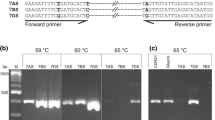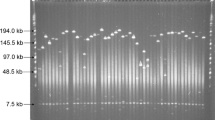Abstract
Pest and disease problems are important constraints of cassava production and host plant resistance is the most efficient method of combating them. Breeding for host plant resistance is considerably slowed down by the crop’s biological constraints of a long growth cycle, high levels of heterozygosity and a large genetic load. More efficient methods such as gene cloning and transgenesis are required to deploy resistance genes. To facilitate the cloning of resistance genes, bacterial artificial chromosome (BAC) library resources have been developed for cassava. Two libraries were constructed from the cassava clones, TMS 30001, resistant to the cassava mosaic disease (CMD) and the cassava bacterial blight (CBB), and MECU72, resistant to cassava white fly. The TMS30001 library has 55 296 clones with an insert size range of 40–150 kb with an average of 80 kb, while the MECU72 library consists of 92 160 clones and an insert size range of 25–250 kb average of 93 kb. Based on a genome size of 772 Mb, the TMS30001 and MECU72 libraries have a 5 and 11.3 haploid genome equivalents and a 95 and 99 chance of finding any sequence, respectively. To demonstrate the potential of the libraries, the TMS30001 library was screened by southern hybridization using a cassava analog (CBB1) of the Xa21 gene from rice that maps to a region containing a QTL for resistance to CBB as probe. Five BAC clones that hybridized to CBB1 were isolated and a Hind III fingerprint revealed 2–3 copies of the gene in individual BAC clones. A larger scale analysis of resistance gene analogs (RGAs) in cassava has also been conducted in order to understand the number and organization of RGAs. To scan for gene and repeat DNA content in the libraries, end-sequencing was performed on 2301 clones from the MECU72 library. A total of 1705 unique sequences were obtained with an average size of 715 bp. Database homology searches using BLAST revealed that 458 sequences had significant homology with known proteins and 321 with transposable elements. The use of the library in positional cloning of pest and disease resistance genes is discussed.
Similar content being viewed by others
References
A. Akano E. Barrera C. Mba A.G.O. Dixon M. Fregene (2002) ArticleTitleGenetic mapping of a dominant gene conferring resistance to the cassava mosaic disease (CMD) Theor. Appl. Genet. 105 521–525 Occurrence Handle10.1007/s00122-002-0891-7 Occurrence Handle12582500
F. Awoleye M. Van Duren J. Dolezel F.J. Novak (1994) ArticleTitleNuclear DNA content and invitro induced somatic polyploidization (Maniholt esculenta Crantz) cassava breeding Euphytica 76 195–202 Occurrence Handle10.1007/BF00022164
B. Ewing P. Green (1998) ArticleTitleBase-calling of automated sequencer traces using phred II Error probabilities. Genome Res. 8 186–194
B. Ewing L. Hillier M. Wendl P. Green (1998) ArticleTitleBase-calling of automated sequencer traces using phred I. Accuracy assessment. Genome Res. 8 175–185
M. Fregene (2000) Marking progress: collaborations to improve cassava D. Kinley (Eds) Synergies in Science, CGIAR Consultative Group on International Agricultural Research Washington DC, USA 6–7
Fregene, M., Buitrago C., Zarate, A. T., Mba, C. and Tohme, J. 2003. Genetic mapping in cassava. Plant Mol. Biol. (in press)
M.A. Fregene F. Angel R. Gómez F. Rodríguez W. Roca J. Tohme M. Bonierbale (1997) ArticleTitleA molecular genetic map of cassava (Manihot esculenta Crantz) Theor. Appl. Genet. TAG 95 IssueID3 431–441
IITA (International Institute of Tropical Agriculture) 1990. In: Annual Report 1990, IITA, Ibadan, Nigeria
Jennings, D.L. 1976. Breeding for resistance to African cassava mosaic. African cassava mosaic, Report of an interdisciplinary Workshop held at Muguga, Kenya. IDRC-071e, pp. 39–44.
V. Jorge M.A. Fregene M.C. Duque M.W. Bonierbale J. Tohme V. Verdier (2000) ArticleTitleGenetic mapping of resistance to bacterial blight disease in cassava (Manihot esculenta Crantz) Theor Appl. Genet. 101(5/6) 865–872
M.A. Marra T.A. Kucaba N.L. Dietrich E.D. Green B. Brownstein K.M. McDonald L.W. Hillier J.D. Mcpherson R.W. Waterston (1997) ArticleTitleHigh-throughput fingerprint analysis of large-insert clones Genome Res 7 1072–1084 Occurrence Handle9371743
R.W. Michelmore I. Paran R.V. Kesseli (1991) ArticleTitleIdentification of markers linked to disease-resistance genes by bulked segregant analysis: a rapid method to detect markers in specific genomic regions by using segregating populations Proc. Nat. Acad. Sci. USA 88 IssueID21 9828–9832 Occurrence Handle1682921
R.F.W. Nichols (1947) ArticleTitleBreeding cassava for virus resistance East Afr. Agric. J. 12 184–194
E. Okogbenin M.C.M. Porto A.G.O. Dixon (1998) Influence of planting season on incidence and severity of African cassava mosaic disease in the sub humic zone of Nigeria M.O. Akoroda I.J. Ekanayake (Eds) Root Crops and Poverty Alleviation IITA, Ibadan Nigeria 388–392
G.W. Otim-Nape A. Bua J.M. Thresh Y. Baguma S. Ogwal G.N. Ssemakula G. Acola B. Byabakama A. Martin (Eds) (1997) Cassava Mosaic Virus Disease in Uganda: The Current Pandemic and Approaches to Control Natural Resources Institute Chatham, U.K.
Peterson, D., Tomkins, J., Frisch, D., Wing, R. and Paterson, A. 2000. Construction of plant bacterial artificial chromosome (BAC) libraries: an illustrated guide. J. Agric. Genomics vol. 5. (http://www.ncgr.org/research/jag/index.html).
J.P. Polston P.K. Anderson (1997) ArticleTitleThe emergence of whitefly-transmitted gemini viruses in tomato in the Western Hemisphere Plant dis. 81 1358–1369
J. Sambrook E. Fritsch T. Maniatis (1989) Molecular Cloning: a Laboratory Manual, 2nd edn Cold Spring Harbor Laboratory Press Cold Spring Harbor, NY
J.M. Thresh D. Fargette G.W. Otim-Nape (1994) ArticleTitleEffects of African cassava mosaic geminivirus on the yield of cassava Trop. Sci. 34 26–42
J. Tomkins Y. Yu H. Miller-Smith D. Frisch S. Woo R. Wing (1999a) ArticleTitleA bacterial artificial chromosome library for sugarcane Theor. Appl. Genet. 99 419–424
J. Tomkins R. Mahalingham H. Miller-Smith J. Goicoechea H. Knapp R. Wing (1999b) ArticleTitleA soybean bacterial artificial chromosome library for PI 437654 and the identification of clones associated with cyst nematode resistance Plant Mol. Biol. 41 25–32
J. Tomkins G. Davis D. Main N. Duru T. Musket J. Goicoechea D. Frisch E. Coe Jr. R. Wing (2002) ArticleTitleConstruction and characterization of a deep-coverage bacterial artificial chromosome library for maize Crop Sci. 42 928–933
J. Tomkins D. Peterson T. Yang D. Main E. Ablett R. Henry L. Lee T. Holton D. Waters R. Wing (2001a) ArticleTitleGrape (Vitis vinifera L.) BAC Library Construction, Preliminary STC analysis, and Identification of Clones Associated with Flavonoid and Stilbene Biosynthesis Am. J. Enol. Vit. 52 287–291
J. Tomkins D. Peterson T. Yang D. Main T. Wilkins A. Paterson R. Wing (2001b) ArticleTitleDevelopment of genomic resources for cotton (Gosypium hirsutum): BAC library development, preliminary STC analysis, and identification of clones associated with fiber development Mol. Breeding 8 255–261
Vargas, O. and Bellotti, A.C. 1981. Perdidas en rendimiento causadas por moscas blancas en el cultivo de la yuca. Rev. Colombia Entomol. 7(1–2): 13–20 (in Spanish)
S. Woo J. Jiang B. Gill A. Paterson R. Wing (1994) ArticleTitleConstruction and characterization of a bacterial artificial chromosome library of Sorghum bicolor Nucl. Acid. Res. 22 4922–4931
H. Zhang X. Zhao X. Ding A. Paterson R. Wing (1995) ArticleTitlePreparation of megabase-size DNA from plant nuclei Plant J. 7 IssueID1 175–184
Author information
Authors and Affiliations
Corresponding author
Rights and permissions
About this article
Cite this article
Tomkins, J., Fregene, M., Main, D. et al. Bacterial artificial chromosome (BAC) library resource for positional cloning of pest and disease resistance genes in cassava (Manihot esculenta Crantz). Plant Mol Biol 56, 555–561 (2004). https://doi.org/10.1007/s11103-004-5045-7
Received:
Issue Date:
DOI: https://doi.org/10.1007/s11103-004-5045-7




